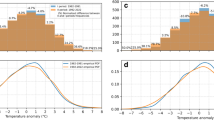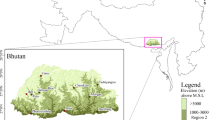Abstract
Under the global warming, it is particularly important to explore the response of extreme climate to global climate change over the arid regions. Based on daily temperature (maximum, minimum, and average) and precipitation data from meteorological stations in Xinjiang, China, we analyzed the spatiotemporal characteristics of extreme temperature and extreme precipitation events via combining thin plate smoothing spline function interpolation, Sen’s slope, and Mann–Kendall test. Our results showed that during 1960–2019, the extreme low temperature index of frost days (FD), icing days (ID), cold days (TX10p), cold nights (TN10p), and cold speel duration index (CSDI) all showed the downward trend to varying degrees, and the extreme high temperature index of summer days (SD25), warm days (TX90p), warm night (TN90p), and warm speel duration index (WSDI) all showed an upward trend to varying degrees, and the extreme low temperature index of high altitude mountains decreases more than that of the basin and plains. In addition, all the extreme temperature indices are closely related to the annual average temperature in Xinjiang (R > 0.6). Among the extreme precipitation indices, except for the consecutive dry days (CDD), the other extreme precipitation indices showed increasing trends to different degrees, but the changes in extreme precipitation in Xinjiang were mainly manifested by the increase of heavy precipitation in a short period (the increase of heavy precipitation and extreme heavy precipitation was the largest, 44.8 mm/10a and 17.6 mm/10a, respectively) and spatially concentrated in the Ili River and Altai Mountains in northern Xinjiang. Meanwhile, annual precipitation was positively correlated with the extreme precipitation index (R > 0.4), except for the CDD. This study provides theoretical support for the prevention and control of natural disasters in the dry zone.









Similar content being viewed by others
Data availability
The datasets generated and/or analyzed during the current study are not publicly available but are available from the corresponding/first author on reasonable request.
References
Aguilar E, Aziz Barry A, Brunet M, Ekang L, Fernandes A, Massoukina M, Mbah J, Mhanda A, Do Nascimento D, Peterson T (2009) Changes in temperature and precipitation extremes in western central Africa, Guinea Conakry, and Zimbabwe, 1955–2006. J Geophys Res: Atmos 114:D02115
Alexander LV, Zhang X, Peterson TC, Caesar J, Gleason B, Klein Tank A, Haylock M, Collins D, Trewin B, Rahimzadeh F (2006) Global observed changes in daily climate extremes of temperature and precipitation. J Geophys Res: Atmos 111:D05109
Barriopedro D, Fischer EM, Luterbacher J, Trigo RM, García-Herrera R (2011) The hot summer of 2010: redrawing the temperature record map of Europe. Science 332:220–224
Bartholy J, Pongrácz R (2007) Regional analysis of extreme temperature and precipitation indices for the Carpathian Basin from 1946 to 2001. Global Planet Change 57:83–95
Ciais P, Reichstein M, Viovy N, Granier A, Ogée J, Allard V, Aubinet M, Buchmann N, Bernhofer C, Carrara A (2005) Europe-wide reduction in primary productivity caused by the heat and drought in 2003. Nature 437:529–533
Cox DT, Maclean IM, Gardner AS, Gaston KJ (2020) Global variation in diurnal asymmetry in temperature, cloud cover, specific humidity and precipitation and its association with leaf area index. Glob Change Biol 26:7099–7111
Della-Marta PM, Haylock MR, Luterbacher J, Wanner H (2007) Doubled length of western European summer heat waves since 1880. J Geophys Res: Atmos 112:D15103
Deng H, Chen Y, Shi X, Li W, Wang H, Zhang S, Fang G (2014) Dynamics of temperature and precipitation extremes and their spatial variation in the arid region of northwest China. Atmos Res 138:346–355
Ding Y, Zhang J, Song Y (2002) Weather and climate extreme affaires and its relationship with global warming. Meteorol Mon 28:3–7
Ding Z, Lu R, Wang Y (2019) Spatiotemporal variations in extreme precipitation and their potential driving factors in non-monsoon regions of China during 1961–2017. Environ Res Lett 14:024005
Donat M, Alexander LV, Yang H, Durre I, Vose R, Dunn RJ, Willett KM, Aguilar E, Brunet M, Caesar J (2013) Updated analyses of temperature and precipitation extreme indices since the beginning of the twentieth century: the HadEX2 dataset. J Geophys Res: Atmos 118:2098–2118
Field CB, Barros V, Stocker TF, Dahe Q (2012) Managing the risks of extreme events and disasters to advance climate change adaptation: special report of the intergovernmental panel on climate change. Cambridge University Press, Cambridge, pp 34–56
Field CB, Barros VR (2014) Climate change 2014–impacts, adaptation and vulnerability: regional aspects. Cambridge University Press, Cambridge, pp 1–1131
Guan X-D, Huang J-P, Guo R-X, Yu H, Lin P, Zhang Y (2015) Role of radiatively forced temperature changes in enhanced semi-arid warming in the cold season over east Asia. Atmos Chem Phys 15:13777–13786
Gumus V, Simsek O, Avsaroglu Y, Agun B (2021) Spatio-temporal trend analysis of drought in the GAP Region, Turkey. Nat Hazards 109:1759–1776
He J, Chen W, Wang Z, Liu P, Wen Z, Xiao X, Wang C, Chao Q, Zou J, Gu A (2016) Climate change mitigation in China. Chin Sci Bull 61:1055–1062
He PX, Ma XL, Sun ZJ, Han ZM, Ma SQ, Meng XY (2022) Compound drought constrains gross primary productivity in Chinese grasslands. Environ Res Lett 17:104054
Hu W, Yao J, He Q, Chen J (2021) Changes in precipitation amounts and extremes across Xinjiang (northwest China) and their connection to climate indices. PeerJ 9:e10792
Huang J-P, Guan X-D, Ji F (2012) Enhanced cold-season warming in semi-arid regions. Atmos Chem Phys 12:5391–5398
Huang J, Ji M, Xie Y, Wang S, He Y, Ran J (2016) Global semi-arid climate change over last 60 years. Clim Dyn 46:1131–1150
Ji F, Wu Z, Huang J, Chassignet EP (2014) Evolution of land surface air temperature trend. Nat Clim Chang 4:462–466
Kunkel KE, Andsager K, Easterling DR (1999) Long-term trends in extreme precipitation events over the conterminous United States and Canada. J Clim 12:2515–2527
Laufkötter C, Zscheischler J, Frölicher TL (2020) High-impact marine heatwaves attributable to human-induced global warming. Science 369:1621–1625
Lewis SL, Brando PM, Phillips OL, Van Der Heijden GM, Nepstad D (2011) The 2010 amazon drought. Science 331:554
Li Y, Huang J, Ji M, Ran J (2015) Dryland expansion in northern China from 1948 to 2008. Adv Atmos Sci 32:870–876
Ling HB, Xu HL, Fu JY, Zhang QQ, Xu XW (2012) Analysis of temporal-spatial variation characteristics of extreme air temperature in Xinjiang, China. Quatern Int 282:14–26
Liu C, Xia J (2004) Water problems and hydrological research in the Yellow River and the Huai and Hai River basins of China. Hydrol Process 18:2197–2210
Luterbacher J, Dietrich D, Xoplaki E, Grosjean M, Wanner H (2004) European seasonal and annual temperature variability, trends, and extremes since 1500. Science 303:1499–1503
Ma Z, Fu C (2003) Interannual characteristics of the surface hydrological variables over the arid and semi-arid areas of northern China. Global Planet Change 37:189–200
Mann HB (1945) Nonparametric tests against trend. Econometrica: J Econom Soc 13:245–259.
Perkins S, Alexander L, Nairn J (2012) Increasing frequency, intensity and duration of observed global heatwaves and warm spells. Geophys Res Lett 39:L20714
Pörtner H-O, Roberts DC, Adams H, Adler C, Aldunce P, Ali E, Begum RA, Betts R, Kerr RB, Biesbroek R (2022) Climate change 2022: impacts, adaptation and vulnerability. IPCC Sixth Assessment Report, pp 1–21
Priestley MD, Pinto JG, Dacre HF, Shaffrey LC (2017) The role of cyclone clustering during the stormy winter of 2013/2014. Weather 72:187–192
Reed SC, Coe KK, Sparks JP, Housman DC, Zelikova TJ, Belnap J (2012) Changes to dryland rainfall result in rapid moss mortality and altered soil fertility. Nat Clim Chang 2:752–755
Sen PK (1968) Estimates of the regression coefficient based on Kendall’s tau. J Am Stat Assoc 63:1379–1389
Speizer S, Raymond C, Ivanovich C, Horton RM (2022) Concentrated and intensifying humid heat extremes in the IPCC AR6 regions. Geophys Res Lett 49:e2021GL097261
Stocker T (2014) Climate change 2013: the physical science basis: working group I contribution to the fifth assessment report of the Intergovernmental Panel on Climate Change. Cambridge University Press, Cambridge, pp 1–1537
Tong R, Sun W, Han Q, Yu J, Tian Z (2020) Spatial and temporal variations in extreme precipitation and temperature events in the Beijing–Tianjin–Hebei region of China over the past six decades. Sustainability 12:1415
Tong S, Li X, Zhang J, Bao Y, Bao Y, Na L, Si A (2019) Spatial and temporal variability in extreme temperature and precipitation events in Inner Mongolia (China) during 1960–2017. Sci Total Environ 649:75–89
Vincent LA, Peterson T, Barros V, Marino M, Rusticucci M, Carrasco G, Ramirez E, Alves L, Ambrizzi T, Berlato M (2005) Observed trends in indices of daily temperature extremes in South America 1960–2000. J Clim 18:5011–5023
Wang B, Zhang M, Wei J, Wang S, Li S, Ma Q, Li X, Pan S (2013) Changes in extreme events of temperature and precipitation over Xinjiang, northwest China, during 1960–2009. Quatern Int 298:141–151
Xu T, Hutchinson MF (2013) New developments and applications in the ANUCLIM spatial climatic and bioclimatic modelling package. Environ Model Softw 40:267–279
Xu Y, Ramanathan V, Victor DG (2018) Global warming will happen faster than we think. Nature 564:30–32
Xuan J, Zheng J, Liu Z (2016) SPEI-based spatiotemporal variation of drought in Xinjiang. Arid Zone Res 33:338–344
Ya R, Li N, Yin S, Bao Y (2020) Characteristics of temporal and spatial variation of extreme climate events in inner Mongolia during the period 1960–2015. Res Soil Water Conserv 27:106–112
Yan W, He Y, Cai Y, Qu X, Cui X (2021) Relationship between extreme climate indices and spatiotemporal changes of vegetation on Yunnan Plateau from 1982 to 2019. Global Ecol Conserv 31:e01813
Zeng N, Yoon J-H, Marengo JA, Subramaniam A, Nobre CA, Mariotti A, Neelin JD (2008) Causes and impacts of the 2005 Amazon drought. Environ Res Lett 3:014002
Zhang Q, Li J, Singh VP, Xu CY (2013) Copula-based spatio-temporal patterns of precipitation extremes in China. Int J Climatol 33:1140–1152
Zhang Q, Singh VP, Li J, Jiang F, Bai Y (2012) Spatio-temporal variations of precipitation extremes in Xinjiang, China. J Hydrol 434:7–18
Funding
This research was funded by the National Key Research and Development Plan (2022YFC3800801), Fundamental Research Fund “Construction of the Key Laboratory of Coastal Science and Integrated Management” (2022L08, 2021L08) and the Ministry of Natural Resources operational special project (GW0422002, GW0122004, TZ0122001).
Author information
Authors and Affiliations
Contributions
Conceptualization, T.D. and D.L.; methodology, T.D.; software and formal analysis, T.D. and P.H.; investigation, T.D. and J.L.; resources, Z.L.; data curation, J.X.; writing—original draft preparation, T.D, M.S, and P.H.; writing, review, and editing, P.H, Z.L, and J.X.; visualization, T.D.; supervision, D.L.; project administration, D.L, and P.H.; funding acquisition, D.L. All the authors have read and agreed to the published version of the manuscript.
Corresponding author
Ethics declarations
Ethical approval and consent to participate
The facts and views in the manuscript are solely ours, and we are responsible for authenticity, validity, and originality. We also declare that this manuscript is our original work, and we have not copied it from anywhere else. No plagiarism is detected in this manuscript.
Consent for publication
We undertook and agreed that the manuscript submitted to your journal has not been published elsewhere and has not been simultaneously submitted to other journals.
Competing interests
The authors declare no competing interests.
Additional information
Responsible Editor: V.V.S.S. Sarma
Publisher's note
Springer Nature remains neutral with regard to jurisdictional claims in published maps and institutional affiliations.
Rights and permissions
Springer Nature or its licensor (e.g. a society or other partner) holds exclusive rights to this article under a publishing agreement with the author(s) or other rightsholder(s); author self-archiving of the accepted manuscript version of this article is solely governed by the terms of such publishing agreement and applicable law.
About this article
Cite this article
Dong, T., Liu, J., Liu, D. et al. Spatiotemporal variability characteristics of extreme climate events in Xinjiang during 1960–2019. Environ Sci Pollut Res 30, 57316–57330 (2023). https://doi.org/10.1007/s11356-023-26514-3
Received:
Accepted:
Published:
Issue Date:
DOI: https://doi.org/10.1007/s11356-023-26514-3




